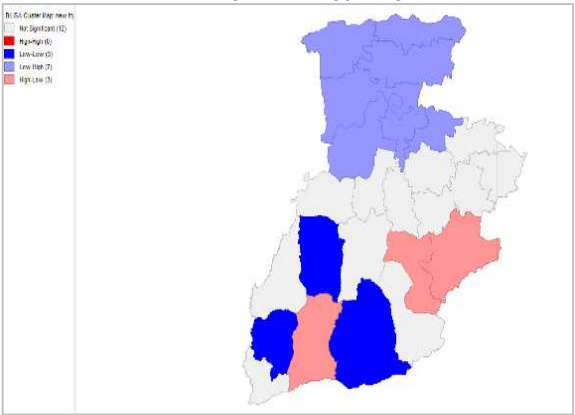Pemetaan Kasus Stunting di Kabupaten Lamongan Tahun 2023
DOI:
https://doi.org/10.5281/zenodo.14561145Keywords:
Stunting, Spatial Autocorrelation , Moran Index, LamonganAbstract
Background: Stunting is a condition in toddlers who experience growth failure due to chronic malnutrition that causes children to be shorter than their group. The results of the Indonesia Nutrition Status Survey (SSGI) in 2022 show that the prevalence of stunting in Lamongan Regency is 27.5%. and is still above the WHO standard of ≤20%. The purpose of this study is to find out if there is a spatial autocorrelation of stunting incidence in Lamongan Regency in 2023. Methods: The methods used are Moran Index, Moran's Scatterplot, Local Indicator of Spatial Association (LISA). Results: The value of the Moran Index of stunting incidence was 0.1851, indicating a positive spatial autocorrelation or forming a grouping pattern. Population Density with Stunting Incidence of -0.1966 indicates a negative spatial autocorrelation or random pattern of spreading. The availability of clean water with a stunting incidence is -0.3497 which indicates a negative spatial autocorrelation or a random spreading pattern. Conclusions: There is a positive Spatial Autocorrelation or forming a clustered pattern in stunting events in Lamongan Regency in 2023, There is a negative spatial autocorrelation of random distribution patterns between population density and stunting events in Lamongan Regency in 2023, There is a negative spatial autocorrelation of random distribution patterns between the availability of clean water and stunting events in Lamongan Regency in 2023.
Downloads
References
Adriani, M., & Wirjatmadi, B. (2016). Peranan Gizi Dalam Siklus Kehidupan. Jakarta: Kencana.
Adzan, G. & Danoedoro, P. (2012). Penggunaan logika fuzzy dalam pemodelan spasial kerentanan DBD di kota Yogyakarta. Jurnal Geografi UGM, 1, 60-67.
Anselin, Luc.(2003). An Introduction to Spatial Regression Analysis in R. Urbana Champaign : university of lllions. diunduh dari : http://sal.agecon.uiuc.edu.
Arbia, G. (2006). Spatial Econometrics: Statistical Foundations and Applications to Regional Convergence. Berlin: Springer.
Aritonang, E.A., Margawati, A., Dieny, F.F. (2020). Analisis Pengeluaran Pangan, Ketahanan Pangan dan Asupan Zat Gizi Anak Bawah Dua Tahun (Baduta) sebagai Faktor Risiko Stunting. Journal of Nutrition College. 9(1). 71–80.
Banerjee, S. (2004). Hierarchical Modeling and Analysis for Spatial Data. Boca Raton: Chapman and Hall/CRC.
Budiastutik, Indah, and Muhammad Zen Rahfiludin. (2019). “Faktor Risiko Stunting Pada Anak Di Negara Berkembang.” Amerta Nutrition 3(3):122–29. doi: 10.2473/amnt.v3i3.2019.122-129
Budiyanto, Eko, 2016. Sistem Informasi Geografis dengan Quantum GIS, Penerbit Andi Yogyakarta.
Candra, A. (2020). Epidemiologi Stunting. Semarang: Universitas Diponegoro
Franch-Pardo, I. et al. (2020) ‘Spatial analysis and GIS in the study of COVID-19. A review’, Science of The Total Environment. doi: 10.1016/j.scitotenv.2020.140033.
Hamzah, B. (2020). Gerakan Pencegahan Stunting Melalui Edukasi pada Masyarakat di Desa Muntoi Kabupaten Bolaang Mongondow. JPKMI (Jurnal Pengabdian Kepada Masyarakat Indonesia), 1(4), 229-235.
Kemenkes RI. Buletin Stunting. Kementeri Kesehat RI. (2018) 301(5):1163–78.
Kementrian Kesehatan RI. (2016). Info. Situasi Balita Pendek, 2442–7659.
Krisnana I, Yunitasari E, Lee BO, Lugina R, Solikhah FK, Aditya RS. (2022) Determining The Factors That Influence Stunting During Pandemic In Rural Indonesia: A Mixed Method. Children. 2022;9(8):1–16.
Krisnana, I., Suryawan, A., & Muftiyaturrohmah, M. (2020). Analysis of fathers’ support based on maternal perceptions through stunting incidence in toddler at coastal areas. Systematic Reviews in Pharmacy, 11(5), 761–767. https://doi.org/10.31838/srp.2020.5.110
Latue, P. C., & Rakuasa, H. (2023). Analisis Spasial Perubahan Tutupan Lahan Di Das Wae Batugantong, Kota Ambon. Jurnal Tanah Dan Sumberdaya Lahan, 10(1), 149–155. https://doi.org/10.21776/ub.jtsl.2023.010.1.17
Lestari, S., Fujianti., Keumalasar, D., Daulay, M. (2018). The Prevalence and Risk Factors of Stunting among Primary School Children in North Sumatera, Indonesia. IOP Conference Series: Earth and Environment Science. 125(1).
Nurmaliza, Herlina S. Hubungan Pengetahuan Dan Pendidikan Ibu Terhadap Status Gizi Balita. Jurnal Kesehatan Masyarakat Asclepius. 2019;126(1):1–7.
Olo, A., Mediani, H. S., & Rakhmawati, W. (2021). Hubungan Faktor Air dan Sanitasi dengan Kejadian Stunting pada Balita di Indonesia. Jurnal Obsesi : Jurnal Pendidikan Anak Usia Dini, 5(2), 1113–1126.
Olsa, ED, Sulastri D dan Anas, E. (2017). Hubungan Sikap ibu Terhadap Kejadian Stunting pada Anak Baru Masuk Sekolah Dasar di Kecamatan Nanggalo. Jurnal Kesehatan Andalas, 6 (3): 523-529
Pfeiffer, dkk. (2008). Spatial Analysis in Epidemologi. Oxford University Press, New York
Prendergast, AJ & Humphrey, JH. (2014). The Stunting Syndrome in Developing Countries. Pediatrics and International Child Health, 34 (4). 250-265
Rachmi CN, Agho KE, Li M, Baur LA (2016). Stunting, Underweight and Overweight in ChildrenAged 2.0–4.9 Years in Indonesia: Prevalence Trends and Associated Risk Factors. PLoS ONE 11(5): e0154756. doi:10.1371/journal.pone.0154756
Rohmawati N, Antika R.B. (2017). Risk Factors Stunting Incidence in Children Aged 6-36 Months in Jember Regency. 3rd International Nursing Conference. 4(5). 128–136.
Rosita, A.D. (2021). Hubungan Pemberian MPASI dan Tingkat Pendidikan Terhadap Kejadian Stunting pada Balita: Literasi Review. Jurnal Penelitian Perawat Profesional. 3(2). 407–412.
Saputri, Rini Archda, and Jeki Tumangger. (2019). “Hulu-Hilir Penanggulangan Stunting Di Indonesia (Upstream and Downstream Stunting Prevention in Indonesia).” Journal of Political Issues 1(1):1–9.
Sulistiyawati, I. (2020). Praktik Pemberian MPASI dengan Status Gizi Bayi di Desa Sukojember Kecamatan Jelbuk Tahun 2020. Jurnal Kebidanan Akademi Kebidanan Jember. 5(1). 16–21.
TNP2K. (2017). 100 Kabupaten/Kota Prioritas Untuk Intervensi Anak Kerdil (Stunting) Ringkasan. Sekretariat Wakil Presiden RI. Jakarta.
Ummah, J. A. (2024). Description of Acute Respiratory Infection in Children at Sukorame Health Centre, Kediri, East Java 2021. Ficco Public Health Journal, 1(01), 7-12.
Zikria. (2018). Hubungan Pola Asuh Ibu Dengan Kejadian Stunting pada Anak Usia 12-35 Bulan di Wilayah Kerja Puskesmas Air Dingin Padang Tahun 2018. Universitas Andalas.
More
Downloads
Published
Issue
Section
License
Copyright (c) 2024 Ananda Azmi Mufida, Mohamad Anis Fahmi (Author)

This work is licensed under a Creative Commons Attribution 4.0 International License.

